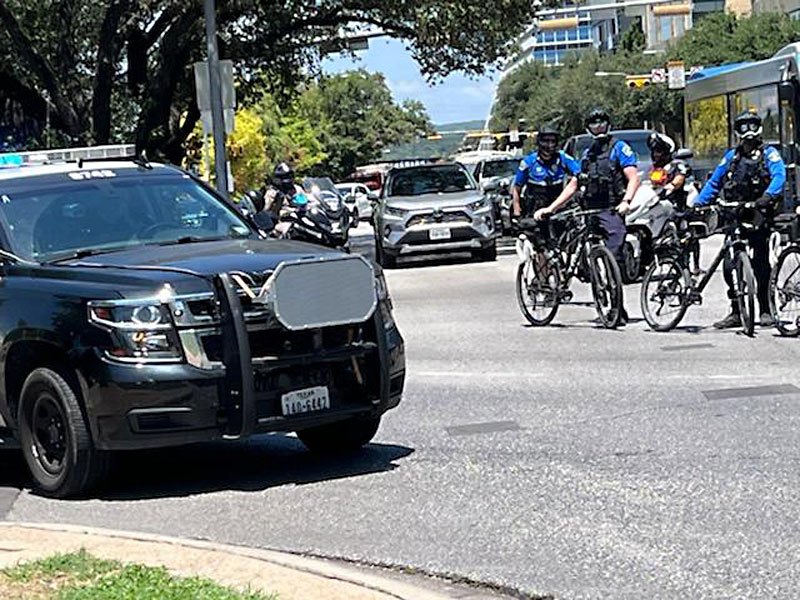Questions Arise About APD's Use of Sound Machines
Sonic warfare?
By Brant Bingamon, Fri., July 29, 2022

Since moving to Austin in 1980, Jim Ellinger has attended more demonstrations Downtown than he cares to remember. The 70-year-old citizen journalist typically stakes out the periphery of a gathering, snapping pics and watching for disturbances. On July 2, Ellinger was following a group of 200 marchers protesting the U.S. Supreme Court decision overturning Roe v. Wade when he encountered something he'd never seen before.
"The crowd was just in front of City Hall, and the APD and DPS units were there," Ellinger said. "The cops were on foot, they were on bicycles and motorcycles, and there was one paddy wagon trailing along – that was not unusual. Then I recognized the unit mounted on the front of a police car. It was an LRAD."
The flat gray piece of military technology that Ellinger observed, known as a long-range acoustic device or LRAD, was designed for the U.S. Navy in the early 2000s for ship-to-ship communication. LRADs work by focusing a beam of sound into a tight cone that can transmit clear speech for over a mile. The Austin Police Department has four of the units, purchased from 2011 to 2016 at a total cost of about $80,000. The department uses them primarily in SWAT operations to communicate with barricaded suspects.
Austin protesters first noticed APD using the device in the May 2020 Black Lives Matter demonstrations, when the department placed an LRAD on the roof of their headquarters on Eighth Street to order the crowds off of I-35. There were worries about LRADs then, and those worries continue, because the devices can emit 160 decibels of sound, which is louder than a jet engine or a gunshot. This sound level can permanently deafen people at close distance, perforate eardrums, and cause disorientation and mild brain injuries. LRADs also have an "alert" tone that emits an irritating sound, which has been used as a sonic weapon. Some believe the devices can interfere with a person's heartbeat.
The LRAD deployed at the July 2 protest appears to be a model 450XL, made by the San Diego firm Genasys. The 450XL's operating manual warns that this model should never be pointed at people within 40 meters of the device. Ellinger told us he believed the LRAD mounted to the police car was 20 meters from the main body of protesters. He said it was never turned on.
Literature on LRADs expands on the operating manual's warning. "The LRAD sound field is innocuous until you are in the midst of it," wrote a researcher from the acoustic consulting firm Acentech in 2020. "Sound levels can go from hardly noticeable to intensely loud within a few footsteps, leaving targets without proper ability to distance themselves or prepare for a potentially dangerous noise exposure."
The city's Public Safety Commission will be asking APD reps for information on how they deploy LRADs at the commission's monthly meeting on Aug. 1. PSC Chair Rebecca Bernhardt anticipates that Austin will be experiencing more large protests with the overturning of Roe v. Wade. "We're concerned about peace officer safety and civilian safety, that we handle protests as safely as possible," Bernhardt said. "We heard that there were issues with the LRAD and we just don't know much about it." The PSC will also be asking APD about its arrest policies for demonstrations, whether the department is surveilling groups that may be planning protests, and what has occurred with the department's stores of nonlethal weapons.
Austin Police Association President Ken Casaday stressed that APD needs LRADs for large protests and that officers do not use them improperly. "We use it because our handheld microphones and our in-car microphones are not able to communicate with the big crowds we've been having for the abortion protests and for the protests back in 2020," he said. "I've been there when they've used it and I know it's not used for nefarious activities. I've asked [fellow officers] if we've ever used it for anything other than communication and they were like, 'Absolutely not. We can't use it to hurt people's ears or to do the other things it can do.'"
Attorney Skip Davis did a deep dive into LRAD technology in 2018, when he defended Tyler Harrell on attempted capital murder charges after SWAT officers tried to use an LRAD to order Harrell out of his house. Davis said his research showed that the officer in charge of communicating with Harrell initially forgot to turn the LRAD on, and that once it was activated it was aimed at the wrong house. Considering the potential for human error, he is dubious about APD using the device to manage protests.
"The LRAD is designed for one specific purpose and one purpose only, according to their own manuals, and that purpose is long-distance ship-to-ship communications," Davis said. "Now I understand they are mounting them on the front of vehicles, which makes them a hundred percent more dangerous. It's one thing to put it over people's heads and subject them to harmful sounds that way. It's another to put it at chest level and pound people with the sonic power that's coming out of it. Because this thing can knock people down. It's deafening. It has a sonic weaponry component to it that if it's close to somebody and you're pumping it at them, you can stop somebody's heart."
Got something to say on the subject? Send a letter to the editor.
Read more of the Chronicle's decades of reproductive rights reporting here.









